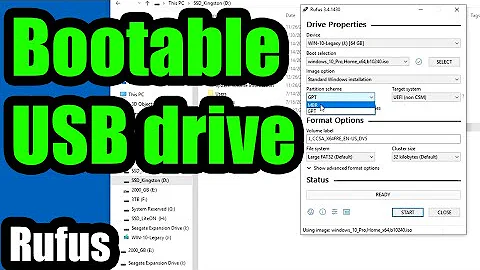Is there an advantage to booting from a USB 3.0 Flash drive?
Solution 1
Answer is very likely no.
I use Openmediavault and a few XBMC boxes (OpenELEC, raspbmc) from SD cards and tried different SD cards/flash drives/SSDs, the performance differs by boot time only. Once an application is started, it operates in RAM. It should be the same with FreeNAS.
Another story would be activity logging and other read/write activities which are performed while OS running (for example if you have MySQL plugin+MySQL installed).
Tolga Hoşgör: In real usage, maximum USB 2.0 transfer rate (with modern chipsets) is ~32MB/s, which could be a bottleneck for some very high speed drives. Usually only USB 3.0 or eSATA flash drives are limited in speed when connected to USB 2.0 connector, because pure USB 2.0 drives typically don't include memory chips faster than ~35MB/s.
Solution 2
Well, the whole OS does not load into RAM as far as I know.
Anyhow, according to this, maximum USB 2.0 bandwidth is 60MB/s but no generic flash drive is close to that yet.
So, the answer is no, you will see no difference between USB 2.0 and 3.0 for flash drives.
EDIT
As babca said, 60MB/s is theoretical speed of USB 2.0. In practice, it is around 30MB/s according to this. I have done some research and found that there are actually some flash drives that go beyond USB 2.0 speed. (did not know because none of them are sold in my country, and also all are too expensive yet)
Focusing back on your question, the answer is still no in my opinion. Because I don't think you will ever use the 32MB/s transfer rate for home use. (you should actually define that home use you said there).
I assume the maximum transfer rate you will need is watching a Blu-Ray film, unless you have a super duper over-240Mbit/sec internet connection bandwidth. Blu-Ray disc's read mechanism allows 4.5MB/s only, so I assume you will be able to watch quite fine.
Conclusion:
You will see little to no benefit from USB 3.0 transfer rate for home use. Adding the over-price of USB 3.0 flash drives to the equation concludes that sticking to USB 2.0 is fine.
Related videos on Youtube
harish_sng
Updated on September 18, 2022Comments
-
 harish_sng almost 2 years
harish_sng almost 2 yearsI have been assigned ETL tasks using talend and have been very impressed with the capabilities of the tool. One common need that I have will be accessing remote MySQL Databases via port forwarding / tunneling. how to do it using Talend? does anyone done it before?
-
Ignacio Vazquez-Abrams almost 12 yearsAre you using it strictly for boot, or will there be any OS files on it?
-
iconoclast almost 12 yearsI'm booting all the way from it, including loading the OS. So perhaps not strictly speaking just booting. But in the most common use of the word, I'm "booting" from it.
-
-
iconoclast almost 12 yearsI'm not understanding your last sentence "(Usually only USB 3.0 or eSATA drives are limited in speed when connected to USB 2.0)".
-
iconoclast almost 12 yearsAre you saying that in general (quite apart from the situation I'm describing) you'll see no difference between USB 2.0 and 3.0 drives?
-
 Hritika Agarwal almost 12 yearsNo difference for flash drives at least. None of them use the full potential of USB 2.0. High speed SSDs and such can go beyond USB 2.0 speed of course. However I'll add a note to the post.
Hritika Agarwal almost 12 yearsNo difference for flash drives at least. None of them use the full potential of USB 2.0. High speed SSDs and such can go beyond USB 2.0 speed of course. However I'll add a note to the post. -
iconoclast almost 12 yearsAnd yet in tests, USB 3.0 flash drives are pretty consistently faster. How does that fit into this picture?
-
 Hritika Agarwal almost 12 yearsThats why I said no usb flash drive will fill the USB 2.0 bandwidth. One of the links in the post after the edit probably includes that USB 2.0 - Firewire comparison you are talking about. However, I see some third party benchmarks show that there are actually really high-speed usb flash drives, but they cost too much.
Hritika Agarwal almost 12 yearsThats why I said no usb flash drive will fill the USB 2.0 bandwidth. One of the links in the post after the edit probably includes that USB 2.0 - Firewire comparison you are talking about. However, I see some third party benchmarks show that there are actually really high-speed usb flash drives, but they cost too much. -
babca almost 12 yearsDon't get confused, that was primarily targeted at Tolga Hoşgör and his "60MB/s statement" (in previous version of his answer). I was trying to say that USB 2.0 flash drives generally don't include memory chips faster than 35MB/s read/write. There's no reason to do so since it would increase the price and would have no effect at overall speed.
-
babca almost 12 yearsBlu-ray, watching films...Tolga, this is totally off-topic!:) FreeNAS is installed on a dedicated hard drive and uses that drive just for the operating system, files cannot be stored on it. User files are stored in shares created on connected SATA hard drives. Files are served in much higher speed from shares (my setup: AMD Zacate+Gbit ethernet+5400RPM drive = 70-130MB/s.)
-
 Hritika Agarwal almost 12 yearsOh, I thought you would use the USB sockets for connecting external drives also. Anyway, I hope I could help about the USB 2.0, 3.0 differences at least.
Hritika Agarwal almost 12 yearsOh, I thought you would use the USB sockets for connecting external drives also. Anyway, I hope I could help about the USB 2.0, 3.0 differences at least.




